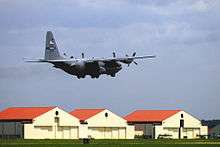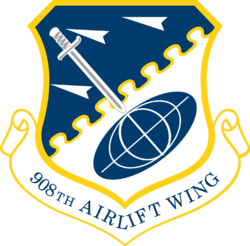908th Airlift Wing
| 908th Airlift Wing | |
|---|---|
|
Emblem of the 908th Airlift Wing | |
| Active | February 11, 1963 - present |
| Country | United States |
| Branch | Air Force |
| Role | Airlift |
| Part of | Twenty-Second Air Force |
| Garrison/HQ | Maxwell Air Force Base |
| Engagements |
Operation Enduring Freedom Operation Iraqi Freedom |
| Decorations |
|

The 908th Airlift Wing is a C-130 theater airlift unit assigned to Air Force Reserve Command. The wing is stationed at Maxwell Air Force Base, Alabama. 908th Airlift Wing's mission is to recruit, organize and train Air Force reservists for active duty in time of war, national emergency or when otherwise required. When mobilized, the mission of the 908th Airlift Wing is to provide theater airlift forces to the supported theater commander.
History
Following the mobilizations in 1961 and 1962 for the Berlin Crisis and the Cuban Missile Crisis, Continental Air Command (ConAC) realized that it was unwieldy to mobilize an entire wing unless absolutely necessary. Their original Table of Organization for each Wing was a wing headquarters, a troop carrier group, an Air Base Group, a maintenance and supply group, and a medical group. In 1957, the troop carrier group and maintenance and supply groups were inactivated, with their squadrons reassigned directly to the wing headquarters — despite the fact that many wings had squadrons spread out over several bases due to the Detached Squadron Concept dispersing Reserve units over centers of population.
To resolve this, in late 1962 and early 1963, ConAC reorganized the structure of its reserve Troop Carrier Wings by establishing fully deployable Troop Carrier Groups and inserting them into the chain of command between the Wing and its squadrons at every base that held a ConAC troop carrier squadron. At each base, the group was composed of a material squadron, a troop carrier squadron, a tactical hospital or dispensary, and a combat support squadron. Each troop carrier wing consisted of 3 or 4 of these groups. By doing so, ConAC could facilitate the mobilization of either aircraft and aircrews alone, aircraft and minimum support personnel (one troop carrier group), or the entire troop carrier wing. This also gave ConAC the flexibility to expand each Wing by attaching additional squadrons, if necessary from other Reserve wings to the deployable groups for deployments.
As a result, the 908th Troop Carrier Group was established with a mission to organize, recruit and train Air Force Reserve personnel in the tactical airlift of airborne forces, their equipment and supplies and delivery of these forces and materials by airdrop, landing or cargo extraction systems. The 908th TCG was initially activated at Clinton County AFB, Ohio as part of the 302d Troop Carrier Wing. It was neither manned or equipped, and was reassigned on 18 Mar 1963 to the 435th Troop Carrier Wing at Bates Field, Mobile, Alabama. The unit was equipped with C-119 "Flying Boxcars," a two-engine transport aircraft that could fly as slowly as 85 mph.
In October 1964, the unit moved to Brookley Air Force Base also in Mobile. There, the 908th built a substantial record of humanitarian airlifts, as well as taking care of regular cargo and mail missions to free Military Airlift Command aircraft committed to Southeast Asia.
On July 16, 1966, a 908th C-119 crashed near Jacksonville, Florida, after losing an engine in a fire. The four crewmen and all 30 Florida National Guard members on board bailed out safely, thanks to the pilot, Maj. Robert C. Coyle of Biloxi, Mississippi. Before ditching the aircraft, Major Coyle saw to it that every passenger and his three crewmen had jumped. For his heroism, he was awarded the Distinguished Flying Cross and the Florida Cross.
In February 1969, another move was announced. The 908th would move to Maxwell Air Force Base, Montgomery, Alabama, the following spring and fly the small, twin-engine U-3H, a forward control aircraft.
The 800-member unit dropped down to a mere 275 people. However, another change was planned: to switch from the U-3H to the O-2A Skymaster, another twin-engine forward air control aircraft.
A year after the March 1970 conversion to O-2As, word arrived that the unit would convert to A-37 jets. Amidst plans for receiving the jets, there was yet another change: the 908th would return to the airlift business flying the C-7A Caribou, a twin-engine utility transport. In December 1971, the 908th was redesignated the 908th Tactical Airlift Group, and the first "Bou" came on board in March 1972.
The 908 TAG was declared combat ready in February 1973, the first C-7 unit in the Air Force Reserve to achieve that status. In its nearly 10 years in the C-7, the 908th won three Air Force Outstanding Unit Awards and dozens of other unit and individual honors.
In October 1983, the 908th converted to C-130E Hercules aircraft. Less than three years later, in June 1986, the unit began receiving new C-130Hs. The transition to the new aircraft culminated in May 1987 at the International Airlift Rodeo competition at Pope Air Force Base, N.C., where the 908th placed as first overall C-130 unit in the world, and fourth place overall among all aircraft competing. This winning tradition continued in 2000 with the 908th winning best C-130/C-160 airdrop aircrew.
In January 1991, medical support personnel from the 908th Medical Squadron and the 35th Aeromedical Evacuation Squadron were activated and deployed in support of Desert Storm. Sixty-two members (doctors, nurses, dentist and lab technicians)of the 908th Medical Squadron were deployed. About 20 members went to Saudi Arabia; the remainder went to Andrews AFB, MD. Members of the 35th Aeromedical Evacuation Squadron (flight nurses and medical technicians) were deployed to the United Kingdom to provide in-flight medical care aboard C-130s and C-141s, to casualties evacuated from the battle zone to hospitals in Europe and CONUS.
In 1992 the 908th Tactical Airlift Group was redesignated the 908th Airlift Group (AG), reporting directly to Tenth Air Force. In 1994, under an Air Force Reserve restructuring, the 908 AG was upgraded to wing status.
Throughout the 1990s the 908 AW supported numerous contingencies, including repeated deployments of volunteers to Europe in support of airlift operations into the former Yugoslavia.
From November 1998 to January 1999, the 908 AW assisted in relief and recovery efforts following Hurricane Mitch in Central America.
Within two days of the September 11, 2001, terrorist attack on the World Trade Center and the Pentagon, 26 908th Security Forces Squadron (SFS) members were called to active duty primarily augmenting the security forces at Maxwell and Gunter in their heightened security efforts. On Nov. 8, fifty-two 908th SFS personnel joined the legions of reservists and Guard members called to active duty in support of the homeland defense effort, Operation Noble Eagle.
In 2002, volunteers from the wing's 908th Aeromedical Evacuation Squadron deployed to Afghanistan in support of Operation Enduring Freedom. They were the first group of airmen to deploy to the war from the wing and received numerous awards including the Air Medal, Army Commendation Medal and the Outstanding Unit Award with Valor.
In December 2003, nearly 250 unit personnel from the wing's C-130 operations and maintenance units were called to active duty to support Operation Enduring Freedom, with more than 180 aircrew members and maintenance and support personnel initially deploying to Central Asia. During the mobilization, the units also supported Operation Iraqi Freedom, deploying to the Persian Gulf region. The units demobilized in November 2005.
Lineage
- Established as the 908th Troop Carrier Group, Medium and activated on 15 January 1963 (not organized)
- Organized in the Reserve on 11 Feb 1963
- Redesignated 908th Tactical Airlift Group on 1 July 1967
- Redesignated 908th Tactical Air Support Group on 25 April 1969
- Redesignated 908th Tactical Airlift Group on 15 December 1971
- Redesignated 908th Airlift Group on 1 February 1992
- Redesignated as: 908th Airlift Wing on 1 October 1994.
Assignments
|
|
Components
- 908th Operations Group: 1 Aug 1992–Present
- 357th Airlift Squadron (Various designations): 11 Feb 1963-1 Aug 1992
Stations
- Clinton County AFB, Ohio, 11 Feb 1963
- Bates Field, Alabama, 18 Mar 1963
- Brookley AFB, Alabama, 1 Oct 1964
- Maxwell AFB, Alabama, 25 Apr 1969–Present
Aircraft
- C-119 Flying Boxcar, 1963-1969
- U-3 "Blue Canoe", 1969-1971
- O-2 Skymaster, 1970-1971
- C-7 Caribou, 1971-1983
- C-130 Hercules, 1983–Present
References
![]() This article incorporates public domain material from websites or documents of the Air Force Historical Research Agency.
This article incorporates public domain material from websites or documents of the Air Force Historical Research Agency.
External links
| |||||||||||||||||||||||||||||||||||||||||||||||
| ||||||||||||||||||||||||||||||||||


